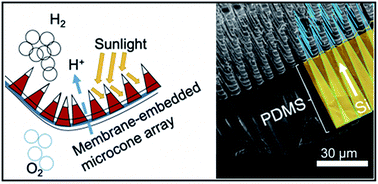Integration of electrocatalysts with silicon microcone arrays for minimization of optical and overpotential losses during sunlight-driven hydrogen evolution†
Abstract
Microstructured photoelectrode morphologies can advantageously facilitate integration of optically absorbing electrocatalysts with semiconducting light absorbers, to maintain low overpotentials for fuel production without producing a substantial loss in photocurrent density. We report herein the use of arrays of antireflective, high-aspect-ratio Si microcones (μ-cones), coupled with light-blocking Pt and Co–P catalysts, as photocathodes for H2 evolution. Thick (∼16 nm) layers of Pt or Co–P deposited onto Si μ-cone arrays yielded absolute light-limited photocurrent densities of ∼32 mA cm−2, representing a reduction in light-limited photocurrent density of 6% relative to bare Si μ-cone-array photocathodes, while maintaining high fill factors and low overpotentials for H2 production from 0.50 M H2SO4(aq). The Si μ-cone arrays were embedded in a flexible polymeric membrane and removed from the Si substrate, to yield flexible photocathodes consisting of polymer-embedded arrays of free-standing μ-cones that evolved hydrogen from 0.50 M H2SO4(aq).

- This article is part of the themed collection: 3rd International Solar Fuels Conference and International Conference on Artificial Photosynthesis


 Please wait while we load your content...
Please wait while we load your content...